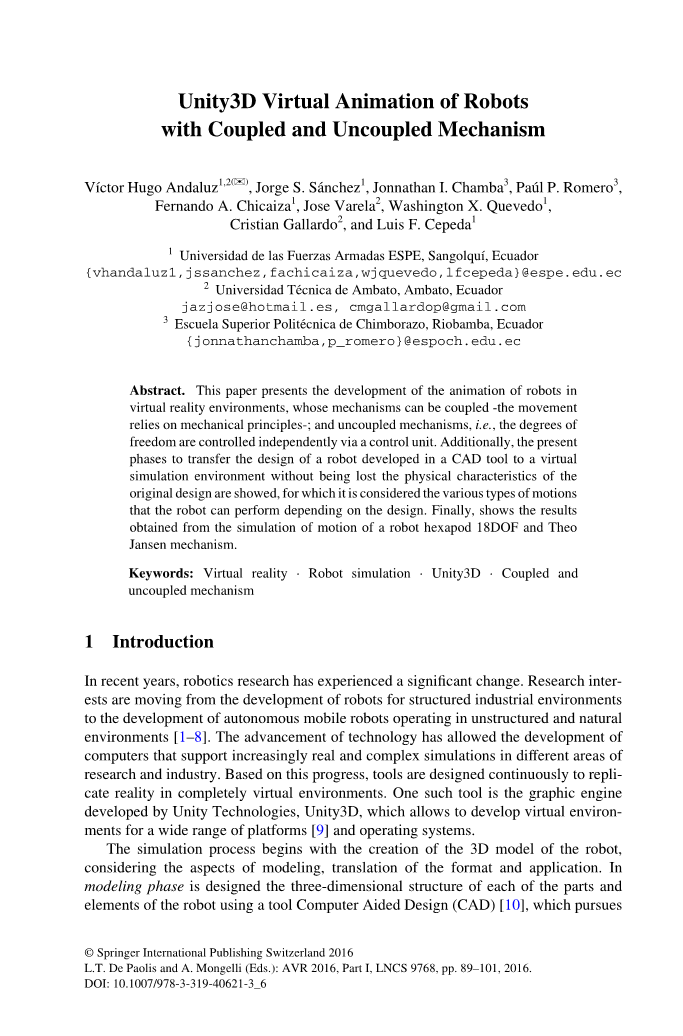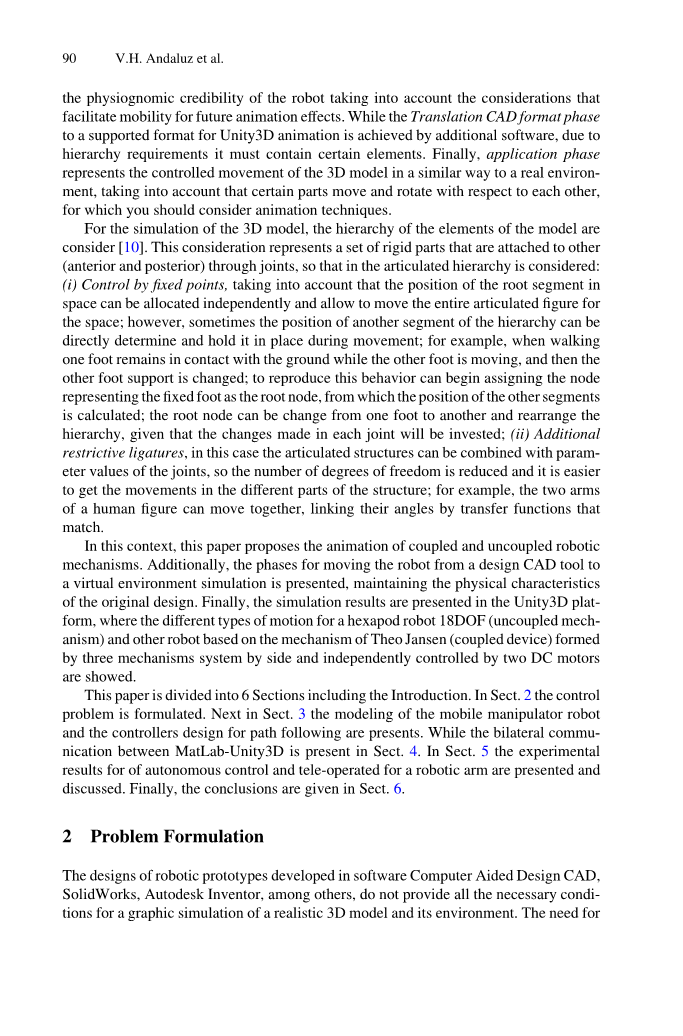

英语原文共 13 页,剩余内容已隐藏,支付完成后下载完整资料
Unity3D Virtual Animation of Robots
with Coupled and Uncoupled Mechanism
Viacute;ctor Hugo Andaluz12, Jorge S. Saacute;nchez1, Jonnathan I. Chamba3, Pauacute;l P. Romero3,
Fernando A. Chicaiza1, Jose Varela2, Washington X. Quevedo1, Cristian Gallardo2, and Luis F. Cepeda1
1 Universidad de las Fuerzas Armadas ESPE, Sangolquiacute;, Ecuador
{vhandaluz1,jssanchez,fachicaiza,wjquevedo,lfcepeda}@espe.edu.ec
2 Universidad Teacute;cnica de Ambato, Ambato, Ecuador
jazjose@hotmail.es, cmgallardop@gmail.com
3 Escuela Superior Politeacute;cnica de Chimborazo, Riobamba, Ecuador
{jonnathanchamba,p_romero}@espoch.edu.ec
Abstract. This paper presents the development of the animation of robots in virtual reality environments, whose mechanisms can be coupled -the movement relies on mechanical principles-; and uncoupled mechanisms, i.e., the degrees of freedom are controlled independently via a control unit. Additionally, the present phases to transfer the design of a robot developed in a CAD tool to a virtual simulation environment without being lost the physical characteristics of the original design are showed, for which it is considered the various types of motions that the robot can perform depending on the design. Finally, shows the results obtained from the simulation of motion of a robot hexapod 18DOF and Theo Jansen mechanism.
Keywords: Virtual reality · Robot simulation · Unity3D · Coupled and uncoupled mechanism
1 Introduction
In recent years, robotics research has experienced a significant change. Research inter‐ ests are moving from the development of robots for structured industrial environments to the development of autonomous mobile robots operating in unstructured and natural environments [1–8]. The advancement of technology has allowed the development of computers that support increasingly real and complex simulations in different areas of research and industry. Based on this progress, tools are designed continuously to repli‐ cate reality in completely virtual environments. One such tool is the graphic engine developed by Unity Technologies, Unity3D, which allows to develop virtual environ‐ ments for a wide range of platforms [9] and operating systems.
The simulation process begins with the creation of the 3D model of the robot, considering the aspects of modeling, translation of the format and application. In modeling phase is designed the three-dimensional structure of each of the parts and elements of the robot using a tool Computer Aided Design (CAD) [10], which pursues
copy; Springer International Publishing Switzerland 2016
L.T. De Paolis and A. Mongelli (Eds.): AVR 2016, Part I, LNCS 9768, pp. 89–101, 2016. DOI: 10.1007/978-3-319-40621-3_6
V.H. Andaluz et al.
90
the physiognomic credibility of the robot taking into account the considerations that facilitate mobility for future animation effects. While the Translation CAD format phase to a supported format for Unity3D animation is achieved by additional software, due to hierarchy requirements it must contain certain elements. Finally, application phase represents the controlled movement of the 3D model in a similar way to a real environ‐ ment, taking into account that certain parts move and rotate with respect to each other, for which you should consider animation techniques.
For the simulation of the 3D model, the hierarchy of the elements of the model are consider [10]. This consideration represents a set of rigid parts that are attached to other (anterior and posterior) through joints, so that in the articulated hierarchy is considered: (i) Control by fixed points, taking into account that the position of the root segment in space can be allocated independently and allow to move the entire articulated figure for the space; however, sometimes the position of another segment of the hierarchy can be directly determine and hold it in place during movement; for example, when walking one foot remains in contact with the ground while the other foot is moving, and then the other foot support is changed; to reproduce this behavior can begin assigning the node representing the fixed foot as the root node, from which the position of the other segments is calculated; the root node can be change from one foot to another and rearrange the hierarchy, given that the changes made in each joint will be invested; (ii) Additional restrictive ligatures, in this case the articulated structures can be combined with param‐ eter values of the joints, so the number of degrees of freedom is reduced and it is easier to get the movements in the different parts of the structure; for example, the two arms of a human figure can move together, linking their angles by transfer functions that match.
In this context, this paper proposes the animation of coupled and uncoupled robotic mechanisms. Additionally, the phases for moving the robot from a design CAD tool to a virtual environment simulation is presented, maintaining the physical characteristics of the original design. Finally, the simulation results are presented in the Unity3D plat‐ form, where the different types of motion for a hexapod robot 18DOF (uncoupled mech‐ anism) and other robot based on the mechanism of Theo Jansen (coupled device) formed by three mechanisms system by side and independently controlled by two DC motors are showed.
This paper is divided into 6 Sections including the Introduction. In Sect. 2 the control problem is formulated. Next in Sect. 3 the modeling of the mobile manipulator robot and the controllers design for path following are presents. While the bilateral commu‐ nication between MatLab-Unity3D is present in Sect. 4. In Sect. 5 the experimental re
剩余内容已隐藏,支付完成后下载完整资料
资料编号:[238249],资料为PDF文档或Word文档,PDF文档可免费转换为Word


